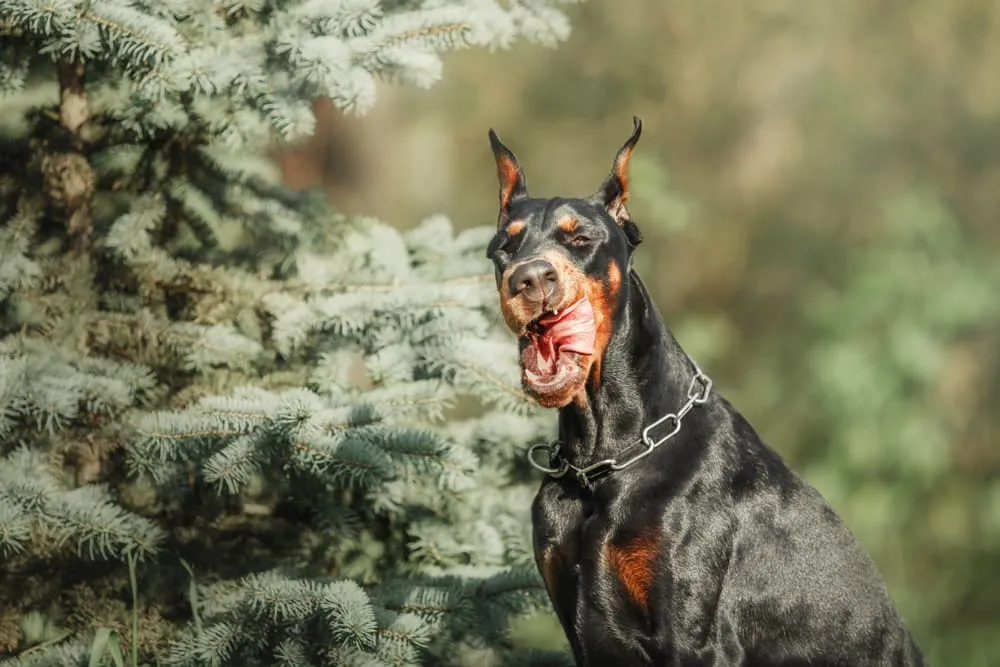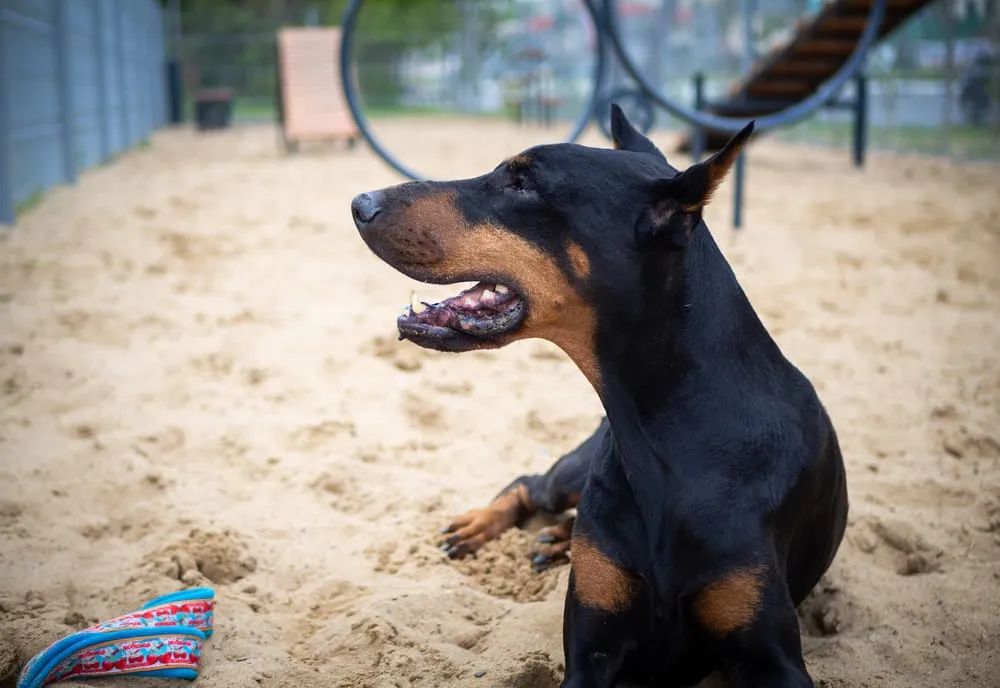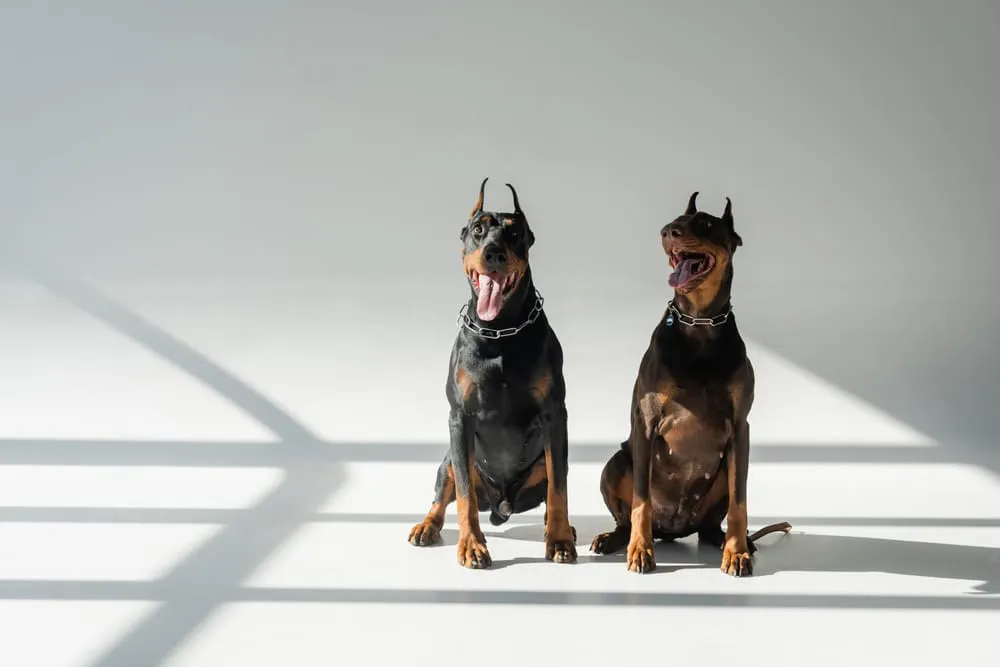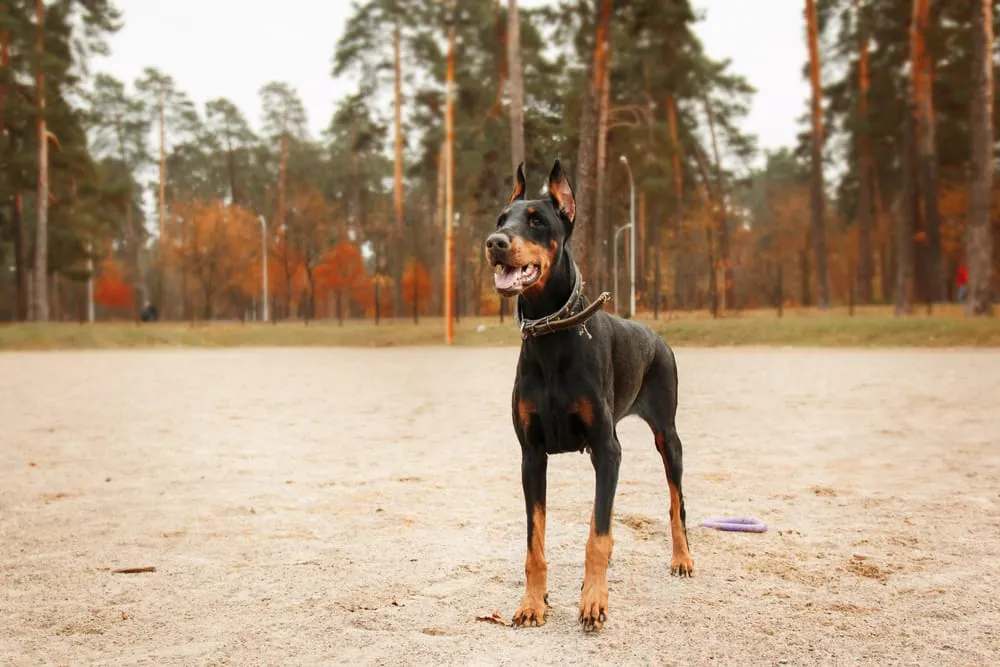The Doberman Pinscher, known for its intelligence, loyalty, and agility, was originally bred as a protector. This article examines one key aspect of the breed: the strength of its bite. While Dobermans are often associated with a strong bite force, it's essential to understand the reality behind this trait to dispel myths and promote responsible ownership. Understanding a Doberman's bite strength is not only about acknowledging their physical capability but also ensuring they are trained and managed responsibly, fostering a safe and respectful relationship between the breed and society.

Understanding Bite Force
Bite force, measured in pounds per square inch (PSI), reflects the power of an animal's jaws. It's a key factor in understanding canine strength, influenced by jaw structure, muscle strength, and temperament. The design of a dog's jaws, including the size and shape, affects bite efficiency and strength, with broader jaws often indicating a stronger bite due to better muscle attachment and leverage. The primary muscles, the temporalis and masseter, are critical for generating force, with their development varying among breeds based on their intended roles, such as guarding or hunting.
A dog's temperament also impacts its bite force; emotional states like fear or aggression can lead to a more forceful bite, whereas training and demeanor can moderate this. Recognizing the variables that influence bite force is vital for responsible ownership and training, ensuring powerful breeds like the Doberman are managed safely. It also informs public interactions with dogs, promoting respectful and cautious engagement to reduce bite incidents. Understanding bite force dynamics is essential for the safe coexistence of humans and dogs, emphasizing the importance of knowledge and responsible practices in pet ownership and society at large.
The Doberman's Jaw Structure and Muscle Composition
The Doberman Pinscher, a breed esteemed for its elegance and power, boasts a jaw structure that is a marvel of canine anatomy. Central to the Doberman's formidable bite is its robust mandible, or lower jaw, which is not only strong but also remarkably efficient in its mechanical design. The jaw's architecture, characterized by a broad base tapering to a more refined point, allows for a concentrated application of force, much like the design of a pair of pliers.
At the heart of the Doberman's bite strength lies its impressive muscle composition. The temporalis and masseter muscles, in particular, play pivotal roles. The temporalis muscle, situated on the side of the skull, is one of the most powerful muscles involved in jaw closure. Its large surface area and fan-like shape enable it to generate significant force when the Doberman bites down. The masseter muscle, on the other hand, is located at the back of the jaw and adds to the crushing power of the bite. This muscle's strength is enhanced by its short fibers, which provide the Doberman with the ability to exert a powerful grip.

Moreover, the efficiency of these muscles is amplified by the leverage provided by the Doberman's jaw structure. The jaw operates on a principle similar to that of a lever, with the joint acting as the fulcrum. The muscles apply force at one end, and the teeth deliver the bite at the other, magnifying the force exerted in the process. This biomechanical advantage allows the Doberman to apply a significant amount of force even with a relatively modest effort from the jaw muscles.
The interplay between the Doberman's jaw anatomy and muscle composition is a testament to the breed's evolutionary design for efficiency and strength. This synergy not only enables the Doberman to deliver a powerful bite but also contributes to its capability for sustained holding, an attribute that has been valued in various roles, from protection to service duties. Understanding this intricate balance provides insight into the remarkable capabilities of this distinguished breed, highlighting the importance of both form and function in the animal kingdom.
How Do Dobermans Compare?
When evaluating the formidable bite of a Doberman, it's essential to place its capabilities in a broader context, not only among other dog breeds but also within the vast spectrum of the animal kingdom. This comparison offers a clearer understanding of where the Doberman stands in terms of bite strength and how this trait influences its interactions with humans and other animals.
Comparison with Other Breeds
The Doberman Pinscher, known for its sleek coat and athletic build, possesses a bite force that is impressive yet not the highest among dog breeds. Studies and anecdotal evidence suggest that the average bite force of a Doberman ranges between 200 to 600 pounds per square inch (PSI). This variability depends on individual factors such as age, health, and training. In comparison, breeds like the Kangal, Mastiff, and Rottweiler showcase higher bite forces, often exceeding 700 PSI. On the other hand, smaller breeds like the Beagle or the Boston Terrier have significantly lower bite forces, typically under 200 PSI. This places the Doberman in a unique position; while it may not top the charts, its bite is powerful enough to demand respect and careful handling.
Dobermans in the Animal Kingdom
When the Doberman's bite force is compared to the broader animal kingdom, the perspective shifts. The sheer diversity of bite strengths across species is staggering. For example, the saltwater crocodile reigns supreme with a bite force exceeding 3,700 PSI, a reflection of its evolutionary adaptations for hunting and survival. Among primates, our closest relatives, the gorilla, can exhibit a bite force of around 1,300 PSI, primarily for cracking nuts and self-defense.
In this vast spectrum, the Doberman's bite force is modest yet significant. It's a testament to the dog's evolution as a protector and companion to humans, where sheer bite strength is balanced with intelligence, trainability, and a temperament suited for close human interaction. This balance ensures that while a Doberman can defend effectively, it can also coexist peacefully within human society when properly trained and socialized.

This contextualization not only highlights the Doberman's place among domesticated and wild animals but also underlines the importance of understanding and respecting the natural capabilities of our canine companions. Whether for protection, companionship, or work, the Doberman's bite is a powerful tool, one that requires knowledge, respect, and responsible management by those who choose to welcome these dignified dogs into their lives.
The Role of Training and Behavior
Training and behavior significantly influence a Doberman's bite, shaping not only the physical capacity of their bite but also the circumstances under which they might use it. Dobermans are highly intelligent and trainable dogs, known for their loyalty and protective instincts. However, these same traits, if not guided properly through training, can lead to aggressive behaviors, including biting.
Training's Impact on Bite Control
Proper training is crucial for Dobermans from a young age. It involves teaching them bite inhibition, a process where they learn to control the force of their bite. This is particularly important for breeds like Dobermans, known for their strong jaw muscles. Through consistent training, a Doberman learns to moderate its bite, understanding that humans and other animals are not threats requiring full force.
Behavioral Influence
A Doberman's behavior is deeply influenced by its training and environment. A well-socialized Doberman, exposed to various people, animals, and situations, is less likely to react aggressively out of fear or anxiety. Training that focuses on positive reinforcement, rather than punishment, fosters trust and respect between the dog and its handler. This approach reduces the likelihood of a fear-based bite and encourages the Doberman to look to its handler for cues on how to react in different situations.
The Role of Obedience Training
Obedience training is another key aspect that impacts a Doberman's potential to bite. Commands like "sit," "stay," "leave it," and "come" are essential for managing a Doberman's behavior in potentially provocative situations. A well-trained Doberman that obeys these commands is less likely to escalate to biting, as it has been taught alternative behaviors to deal with stress or threats.
Managing Protective Instincts
Dobermans are naturally protective, a trait that, while beneficial in some contexts, requires careful management to prevent aggressive responses, including biting. Training should focus on teaching the Doberman to distinguish between normal and threatening situations, ensuring they do not perceive every unfamiliar person or animal as a threat to their family or territory.
The Importance of Consistency
Consistency in training and behavior management is crucial for Dobermans. Inconsistent rules or sporadic training sessions can confuse the dog, leading to unpredictable behavior. A consistent training regimen reinforces learned behaviors and ensures the Doberman understands what is expected of it, reducing the likelihood of biting out of confusion or frustration.
In conclusion, the role of training and behavior in managing a Doberman's bite is multifaceted and essential. Through responsible training focused on bite inhibition, obedience, socialization, and understanding the Doberman's protective instincts, owners can significantly influence their dog's behavior. This not only ensures the safety of others but also enhances the bond between the dog and its owner, creating a more harmonious living environment for everyone involved.

Myths vs. Reality
The Doberman Pinscher, with its imposing stature and sharp intellect, often falls victim to numerous myths surrounding its aggression and bite force. These misconceptions can lead to unwarranted fear and stigma against the breed. By addressing these myths with factual information, we can foster a more accurate understanding of the Doberman's true nature.
Myth 1: Dobermans Are Naturally Aggressive
Reality: Dobermans are not inherently aggressive. Like any breed, their temperament is influenced by a variety of factors, including genetics, upbringing, socialization, and training. Originally bred for protection, Dobermans do have a strong protective instinct, but this does not equate to unprovoked aggression. When properly trained and socialized, Dobermans are known to be loyal, loving, and gentle with their families.
Myth 2: Doberman's Bite Force is Among the Strongest
Reality: While Dobermans possess a strong bite, their bite force is not the highest among dog breeds. Scientific studies measuring bite force in PSI (pounds per square inch) have shown that several breeds have a stronger bite. The focus on a Doberman's bite force often overlooks the more important factors of temperament and training, which play a crucial role in a dog's behavior and likelihood to bite.
Myth 3: Dobermans Turn on Their Owners
Reality: The myth that Dobermans, or any breed for that matter, will spontaneously turn on their owners is unfounded and perpetuates unnecessary fear. Incidents where dogs have turned on their owners often involve extenuating circumstances such as abuse, neglect, lack of training, or undiagnosed health issues. Dobermans who are raised in a loving, respectful environment and given proper training and socialization are highly unlikely to exhibit such behavior.
Myth 4: Dobermans Are Not Good Family Pets
Reality: Contrary to the myth that Dobermans are not suitable for families, they can make excellent family pets when their environment is stable, loving, and structured. They are known to be particularly loyal and affectionate with children they are raised with, provided that both the dog and the children are taught to interact with each other safely and respectfully.
By dispelling these myths with factual information, we can appreciate the Doberman's true character and potential as a companion. Understanding the breed's needs for training, socialization, and affection helps to prevent behavioral issues and reduces the likelihood of biting incidents. It's essential to base our perceptions of Dobermans on evidence and personal experience rather than on stereotypes and misinformation.

Practical Implications of Bite Strength
The bite strength of a Doberman, while not the highest among dog breeds, is still formidable and carries significant implications in domestic settings. Understanding and managing this aspect of the Doberman's physical capability is crucial for ensuring the safety and well-being of both the dog and its human family.
Implications in Domestic Settings
A strong bite in a domestic setting can lead to unintentional injuries, especially if the dog has not been taught bite inhibition. Even in play, a Doberman might not realize its own strength, which could result in harm to children or other pets. Moreover, in situations where the dog feels threatened or is in pain, its natural instinct might lead to a defensive bite. Recognizing these risks is the first step in mitigating potential problems.
Tips for Managing and Training Dobermans
- Early Socialization: Expose your Doberman to a variety of people, animals, environments, and situations from a young age. Positive experiences during the critical socialization period can reduce fearfulness and aggression, making the dog less likely to use its bite out of fear or anxiety.
- Bite Inhibition Training: Teach your Doberman bite inhibition from puppyhood. This involves letting the puppy learn to moderate the force of its bites, especially during play, so that it understands how to control its jaw strength.
- Obedience Training: Consistent obedience training establishes clear communication and boundaries. Commands like "leave it," "drop it," or "stay" can prevent situations from escalating to a point where the dog might feel compelled to bite.
- Positive Reinforcement: Use rewards-based training to encourage desired behaviors. Positive reinforcement not only strengthens the bond between you and your Doberman but also promotes a willingness to comply without the need for physical strength or intimidation.
- Exercise and Mental Stimulation: Dobermans are energetic and intelligent dogs that require regular physical exercise and mental stimulation. A well-exercised dog is generally more relaxed and less likely to exhibit problematic behaviors, including inappropriate biting.
- Professional Training Classes: Consider enrolling your Doberman in professional training classes, especially if you are a first-time dog owner. These classes can provide valuable guidance on training techniques and behavior management.
- Health Check-ups: Regular veterinary care is essential to ensure your Doberman is in good health. Pain or discomfort from medical issues can increase a dog's likelihood to bite. Addressing health problems promptly can prevent pain-induced aggression.
- Respect Your Dog's Space: Teach all family members, especially children, to recognize and respect when the dog needs space. A dog forced into uncomfortable situations is more likely to react negatively.
Conclusion
Exploring a Doberman's bite strength goes beyond physicality, emphasizing the essence of responsible ownership and training. This article has debunked common myths, highlighted the role of proper socialization, and the impact of training on managing bite risks. It advocates for a balanced approach that respects the Doberman's capabilities while nurturing their positive traits. Embracing these principles fosters a fulfilling relationship with this noble breed, built on mutual respect and understanding.




